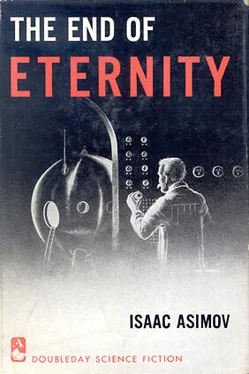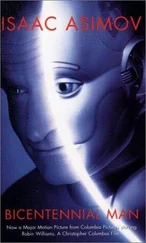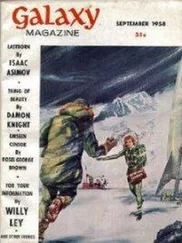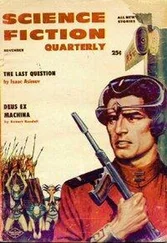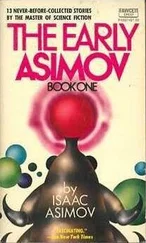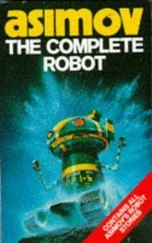Isaac Asimov - The End of Eternity
Здесь есть возможность читать онлайн «Isaac Asimov - The End of Eternity» весь текст электронной книги совершенно бесплатно (целиком полную версию без сокращений). В некоторых случаях можно слушать аудио, скачать через торрент в формате fb2 и присутствует краткое содержание. Город: Garden City, N.Y., Издательство: The Country Life Press, Жанр: Фантастика и фэнтези, на английском языке. Описание произведения, (предисловие) а так же отзывы посетителей доступны на портале библиотеки ЛибКат.
- Название:The End of Eternity
- Автор:
- Издательство:The Country Life Press
- Жанр:
- Год:неизвестен
- Город:Garden City, N.Y.
- ISBN:нет данных
- Рейтинг книги:5 / 5. Голосов: 1
-
Избранное:Добавить в избранное
- Отзывы:
-
Ваша оценка:
- 100
- 1
- 2
- 3
- 4
- 5
The End of Eternity: краткое содержание, описание и аннотация
Предлагаем к чтению аннотацию, описание, краткое содержание или предисловие (зависит от того, что написал сам автор книги «The End of Eternity»). Если вы не нашли необходимую информацию о книге — напишите в комментариях, мы постараемся отыскать её.
“Asimov . . . at the height of his powers.”
Brian Aldiss “Monumentally good ideas . . . fascinating.”
Damon Knight
The End of Eternity — читать онлайн бесплатно полную книгу (весь текст) целиком
Ниже представлен текст книги, разбитый по страницам. Система сохранения места последней прочитанной страницы, позволяет с удобством читать онлайн бесплатно книгу «The End of Eternity», без необходимости каждый раз заново искать на чём Вы остановились. Поставьте закладку, и сможете в любой момент перейти на страницу, на которой закончили чтение.
Интервал:
Закладка:
“What we did then instead was this: We sent back a known mass of the radioactive isotope, niobium-94, which decays by beta-particle emission to the stable isotope, molybdenum-94. The process has a halflife of almost exactly 500 Centuries. The original radiation intensity of the mass was known. That intensity decreases with time according to the simple relationship involved in first-order kinetics, and, of course, the intensity can be measured with great precision.
“When the kettle reaches its destination in Primitive times, the ampule containing the isotope is discharged into the mountainside and the kettle then returns to Eternity. At the moment in physiotime that the ampule is discharged, it simultaneously appears at all future Times growing progressively older. At the place of discharge in the 575th (in actual Time and not in Eternity) a Technician detects the ampule by its radiation and retrieves it.
“The radiation intensity is measured, the time it has remained in the mountainside is then known, the Century to which the kettle traveled is also known to two decimal places. Dozens of ampules were thus sent back at various thrust levels and a calibration curve set up. The curve was a check against ampules sent not all the way into the Primitive but into the early Centuries of Eternity where direct observations could also be made.
“Naturally, there were failures. The first few ampules were lost until we learned to allow for the not too major geological changes between the late Primitive and the 575th. Then, three of the ampules later on never showed up in the 575th. Presumably, something went wrong with the discharge mechanism and they were buried too deeply in the mountain for detection. We stopped our experiments when the level of radiation grew so high that we feared that some of the Primitive inhabitants might detect and wonder what radioactive artifacts might be doing in the region. But we had enough for our purposes and we are certain we can send back a man to any hundredth of a Century of the Primitive that is desired.
“You follow all this, Cooper, don’t you?”
Cooper said, “Perfectly, Computer Twissell. I have seen the calibration curve without understanding the purpose at the time. It is quite clear now.”
But Harlan was exceedingly interested now. He stared at the measured arc marked off in centuries. The shining arc was porcelain on metal and the fine lines divided it into Centuries, Decicenturies and Centicenturies. Silvery metal gleamed thinly through the porcelainpenetrating lines, marking them clearly. The figures were as finely done and, bending close, Harlan could make out the Centuries from 17 to 27. The hairline was fixed at the 23.17th Century mark.
He had seen similar time-gauges and almost automatically he reached to the pressure-control lever. It did not respond to his grasp. The hairline remained in place.
He nearly jumped when Twissell’s voice suddenly addressed him.
“Technician Harlan!”
He cried, “Yes, Computer,” then remembered that he could not be heard. He stepped to the window and nodded.
Twissell said, almost as though chiming in with Harlan’s thoughts, “The time-gauge is set for a thrust back to the 23.17th. That requires no adjustment. Your only task is to pour energy through at the proper moment in physiotime. There is a chronometer to the right of the gauge. Nod if you see it.”
Harlan nodded.
“It will reach zero-point backward. At the minus-fifteen-second point, align the contact points. It’s simple. You see how?”
Harlan nodded again.
Twissell went on, “Synchronization is not vital. You can do it at minus fourteen or thirteen or even minus five seconds, but please make every effort to stay this side of minus ten for safety’s sake. Once you’ve closed contact, a synchronized force-gear will do the rest and make certain that the final energy thrust will occur precisely at time zero. Understood?”
Harlan nodded still again. He understood more than Twissell said. If he himself did not align the points by minus ten, it would be taken care of from without.
Harlan thought grimly: There’ll be no need for outsiders.
Twissell said, “We have thirty physiominutes left. Cooper and I will leave to check on the supplies.”
They left. The door closed behind them, and Harlan was left alone with the thrust control, the time (already moving slowly backward toward zero)—and a resolute knowledge of what must be done.
Harlan turned away from the window. He put his hand inside his pocket and half withdrew the neuronic whip it still contained. Through all this he had kept the whip. His hand shook a little.
An earlier thought recurred: a Samson-smash of the temple!
A corner of his mind wondered sickly: How many Eternals have ever heard of Samson? How many know how he died?
There were only twenty-five minutes left. He was not certain how long the operation would take. He was not really certain it would work at all.
But what choice had he? His damp fingers almost dropped the weapon before he succeeded in unhinging the butt.
He worked rapidly and in complete absorption. Of all the aspects of what he planned, the possibility of his own passage into nonexistence occupied his mind the least and bothered him not at all.
At minus one minute Harlan was standing at the controls.
Detachedly he thought: The last minute of life?
Nothing in the room was visible to him but the backward sweep of the red hairline that marked the passing seconds.
Minus thirty seconds.
He thought: It will not hurt. It is not death.
He tried to think only of Noÿs.
Minus fifteen seconds.
Noÿs!
Harlan’s left hand moved a switch down toward contact. Not hastily!
Minus twelve seconds.
Contact!
The force-gear would take over now. Thrust would come at zero time. And that left Harlan one last manipulation. The Samson-smash!
His right hand moved. He did not look at his right hand.
Minus five seconds.
Noÿs!
His right hand mo—ZERO—ved again, spasmodically. He did not look at it.
Was this nonexistence?
Not yet. Nonexistence not yet.
Harlan stared out the window. He did not move. Time passed and he was unaware of its passage.
The room was empty. Where the giant, enclosed kettle had been was nothing. Metal blocks that had served as its base sat emptily, lifting their huge strength against air.
Twissell, strangely small and dwarfed in the room that had become a waiting cavern, was the only thing that moved as he tramped edgily this way and that.
Harlan’s eyes followed him for a moment and then left him.
Then, without any sound or stir, the kettle was back in the spot it had left. Its passage across the hairline from time past to time present did not as much as disturb a molecule of air.
Twissell was hidden from Harlan’s eyes by the bulk of the kettle, but then he rounded it, came into view. He was running.
A flick of his hand was enough to activate the mechanism that opened the door of the control room. He hurtled inside, shouting with an almost lyrical excitement. “It’s done. It’s done. We’ve closed the circle.” He had breath to say no more.
Harlan made no answer.
Twissell stared out the window, his hands flat against the glass. Harlan noted the blotches of age upon them and the way in which they trembled. It was as though his mind no longer had the ability or the strength to filter the important from the inconsequential, but were selecting observational material in a purely random manner.
Wearily he thought: What does it matter? What does anything matter now?
Twissell said (Harlan heard him dimly), “I’ll tell you now that I’ve been more anxious than I cared to admit. Sennor used to say once that this whole thing was impossible. He insisted something must happen to stop it— What’s the matter?”
Читать дальшеИнтервал:
Закладка:
Похожие книги на «The End of Eternity»
Представляем Вашему вниманию похожие книги на «The End of Eternity» списком для выбора. Мы отобрали схожую по названию и смыслу литературу в надежде предоставить читателям больше вариантов отыскать новые, интересные, ещё непрочитанные произведения.
Обсуждение, отзывы о книге «The End of Eternity» и просто собственные мнения читателей. Оставьте ваши комментарии, напишите, что Вы думаете о произведении, его смысле или главных героях. Укажите что конкретно понравилось, а что нет, и почему Вы так считаете.
